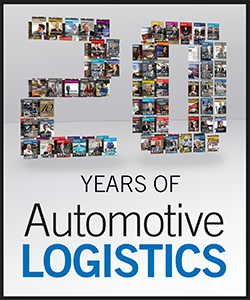How has your company’s supply chain and logistics management organisation changed over the past 20 years?
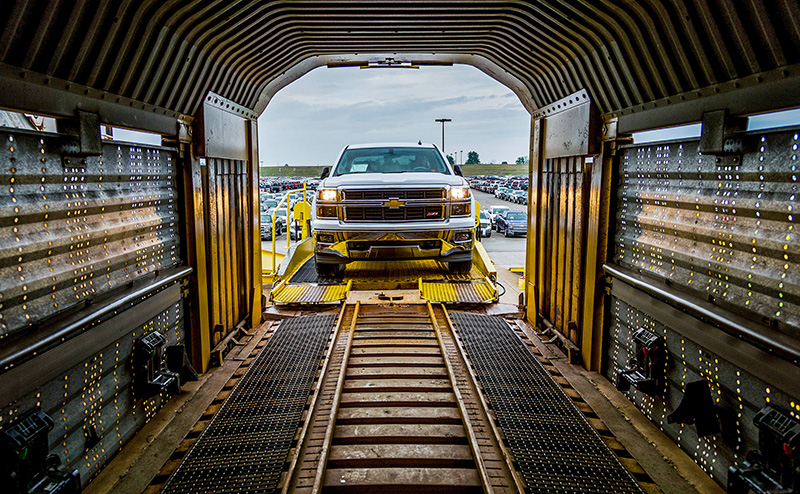 How has your company’s supply chain and logistics management organisation changed over the past 20 years?
How has your company’s supply chain and logistics management organisation changed over the past 20 years?
Carmakers often tinker with their logistics division, sometimes moving it from one department to another, adding or subtracting functions. Over the past decade, for example, BMW moved its logistics from purchasing to be part of manufacturing. Chrysler, which prior to its merger with Daimler kept its logistics division under manufacturing, combined it with procurement as DaimlerChrysler. When the two split, Chrysler put supply back under manufacturing, only for its marriage with Fiat several years later to result in a new, standalone supply chain management division.
More recently, Daimler made its own changes. In 2015, as part of a specific effort to reduce logistics costs per vehicle, Mercedes-Benz realigned its logistics organisation, combining in-plant logistics in a central organisation along with capacity planning, inbound and outbound logistics, headed by Alexander Koesling. Previously, plant logistics was managed by individual plants. Koesling now reports directly to the Mercedes-Benz Car board member for production and supply chain management (Markus Schäfer).
 Until 2004, Volkswagen Group had no central group logistics function to coordinate planning, capacity, standards and consolidation across brands. Rather, each brand or region led logistics, while Volkswagen Logistics acted as a separate service provider to purchase capacity and serve each brand. Zernechel took over the new group function in 2004 with just 23 people. In 2009, group logistics absorbed Volkswagen Logistics, and today it has nearly 800 employees overseeing shared inbound and outbound logistics transport and standards across the brands.
Until 2004, Volkswagen Group had no central group logistics function to coordinate planning, capacity, standards and consolidation across brands. Rather, each brand or region led logistics, while Volkswagen Logistics acted as a separate service provider to purchase capacity and serve each brand. Zernechel took over the new group function in 2004 with just 23 people. In 2009, group logistics absorbed Volkswagen Logistics, and today it has nearly 800 employees overseeing shared inbound and outbound logistics transport and standards across the brands.
Honda also didn’t have an integrated department in North America, with plants mainly responsible for their own inbound logistics. Part of the impetus for change came during the west coast port lockout of 2002, after which point Dana McBrien took over import and later domestic inbound logistics. Today, McBrien’s team is responsible for inbound logistics and logistics facilities up to the delivery docks or onsite consolidation centres at US plants, as well as freight to or from the border (although it often gets directly involved with Mexican and Canadian operations, too).
In China, Ma Zengrong says OEMs have moved from plant-based organisation and disjointed or non-existent logistics management to specialised management organisations.
Despite these significant changes, it is difficult to point to one pattern across logistics organisations in the past 20 years. Some supply chain departments have further centralised responsibilities, while others take a more decentralised or regional approach. Overall, however, manufacturers have more multi-functional logistics groups who increasingly interact across departments, and whose focus tends to go beyond transport to include capacity and order management, and even sales and demand planning.
Logistics departments are also often more global than in the past. At Ford, whose MP&L department is among the least changed in terms of functions and reporting lines, Dirk Willmann says there is now considerably more communication and interaction amongst regional teams, including collaborating on capacity and supply management.
 The significance of logistics costs, as well as the impact that logistics has on the stability of production and distribution, has also increased the influence and visibility of supply chain management across companies. At GM, Edgard Pezzo says that its logistics department is now much more involved in planning future models and production programmes.
The significance of logistics costs, as well as the impact that logistics has on the stability of production and distribution, has also increased the influence and visibility of supply chain management across companies. At GM, Edgard Pezzo says that its logistics department is now much more involved in planning future models and production programmes.
Magna’s Michael Druml observes that, regardless of what logistics or supply chain departments are called, they now include more elements of the value chain, including supplier development, ordering, transport, systems, network engineering and materials handling. Earlier this year, Groupe PSA realigned its supply chain department to include demand planning, thus creating more of a sales and operations planning (S&OP) function. GM has put its logistics under a ‘demand/supply’ function, while FCA also includes S&OP in its supply chain organisation.
At Mercedes-Benz, Volkswagen Group, Ford and others, the role of production planning and logistics systems, including constraints for parts and sales orders, is increasingly vital to their supply chain management. To that end they are as – or more – focused on monitoring the supply base and optimising production as on physical logistics operations.
Have you outsourced significant functions in your logistics, or brought others in-house, compared to 20 years ago?
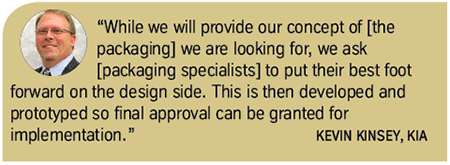 Logistics management outsourcing also tends to move in pendulum swings between handing over more responsibilities to third parties, and building up internal teams. Such changes at carmakers depend on economic and regional conditions, but also the management strategy of the day. General Motors, for example, famously spun off its logistics management in a joint venture in the early 2000s, only to bring it back in-house in 2006. In a financial deal with PSA years before GM sold it Opel/Vauxhall, it also outsourced its European logistics management to then PSA-owned Gefco. Volvo Cars, which under Ford left its logistics management to a third party, also brought logistics in-house several years ago.
Logistics management outsourcing also tends to move in pendulum swings between handing over more responsibilities to third parties, and building up internal teams. Such changes at carmakers depend on economic and regional conditions, but also the management strategy of the day. General Motors, for example, famously spun off its logistics management in a joint venture in the early 2000s, only to bring it back in-house in 2006. In a financial deal with PSA years before GM sold it Opel/Vauxhall, it also outsourced its European logistics management to then PSA-owned Gefco. Volvo Cars, which under Ford left its logistics management to a third party, also brought logistics in-house several years ago.
For most companies, the changes in outsourcing are not quite so extreme either way. Executives point to the outsourcing of logistics network management to lead logistics providers over the past two decades, including route engineering, carrier management and sometimes carrier purchasing, freight billing and invoicing. For outbound, some carmakers have outsourced or partnered with providers in similar ways to manage visibility over deliveries. Many also outsource in-plant logistics and line feeding.
In China, where state-owned carmakers typically own logistics providers, Ma Zengrong points to higher levels of outsourcing over the past decade across virtually all areas of logistics, including operations and management.
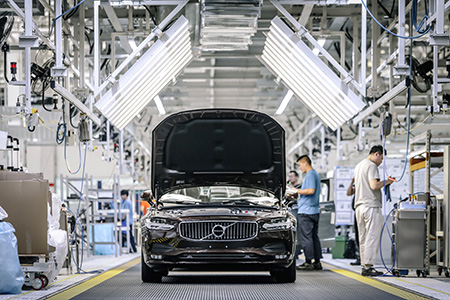 In China, OEMs have increased substantially their outsourcing of manufacturing and logistics services
In China, OEMs have increased substantially their outsourcing of manufacturing and logistics servicesIn western markets, the outsourcing of inbound road and consolidation networks started to increase more rapidly for some carmakers around 20 years ago. It was then that Ford outsourced much of its inbound road network across Europe to DHL as an LLP, for example; the company has similar LLP models in places in other major regions, including recently in India and China. Honda outsourced its US inbound transport network engineering to Ceva (now TNT) not long after creating its central logistics function. In North America, GM has long used LLPs like Ryder and Penske to manage its inbound transport network and engineering. According to Pezzo, GM outsources more logistics services today, compared to 20 years ago.
In-plant services such as line feeding have also been outsourced more in this period. Dana McBrien says that Honda outsourced line feeding in the US for nearly all locations as an extension of outsourcing its parts consolidation centres, most of which are at plant sites. A Honda-owned logistics company is the primary provider for such services, but there are also external providers managing line delivery.
An executive at a premium European carmaker admits that his company has at times outsourced in-plant logistics to save on fixed costs, though it has also brought it back in-house when economic circumstances have changed.
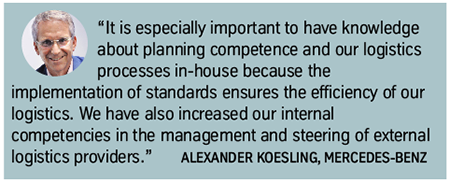 Michael Druml cites external warehouse operations and packaging planning as other areas that have been outsourced more. Kevin Kinsey agrees that packaging design has been a useful area in which to work more with outside experts to keep up with trends in packaging design.
Michael Druml cites external warehouse operations and packaging planning as other areas that have been outsourced more. Kevin Kinsey agrees that packaging design has been a useful area in which to work more with outside experts to keep up with trends in packaging design.
However, even where areas have been outsourced, executives say the internal skills and competences of OEM logistics organisations have become more important. 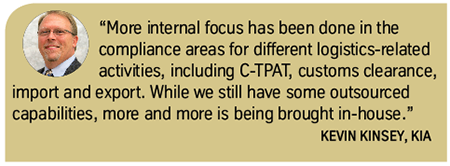 Whether IT, operations or network design, managers need not only to track their providers’ KPIs but to have the understanding and competences of the services to support providers.
Whether IT, operations or network design, managers need not only to track their providers’ KPIs but to have the understanding and competences of the services to support providers.
There are also signs of manufacturers looking to take some areas back in-house or at least to gain more knowledge, whether in logistics network design or in things like customs and regulations. At GM, which for decades outsourced inbound network management to LLPs in North America, management has sought to increase inbound engineering capabilities again, says Pezzo.
Ford outsourced customs and duty work in the early 2000s and it remains external, but Dirk Willmann confirms that the complexities of global customs – including the potential risks from Brexit in future – and the potential benefits from big data, have led MP&L to strengthen its internal team of experts. At Kia, Kevin Kinsey has also seen an increase of in-house resource for dealing with customs as well as regulatory security issues, like the US programme C-TPAT (Customs-Trade Partnership Against Terrorism).
What skills does a supply chain manager at your company need to succeed compared to 20 years ago?
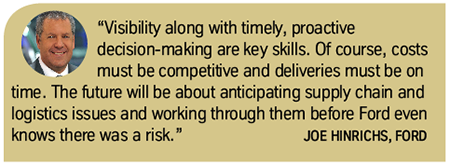 With so many aspects of systems, technology and geography having changed in the automotive supply chain in the past two decades, it would appear that the jobs logistics managers do today, and indeed will do tomorrow, are considerably different. That is true in the eyes of many leading executives, who say logistics managers need to understand more technical aspects of IT and interfaces. However, executives also stress the need for an open mind and the ability to see the supply chain in terms much wider than transport lanes or rates.
With so many aspects of systems, technology and geography having changed in the automotive supply chain in the past two decades, it would appear that the jobs logistics managers do today, and indeed will do tomorrow, are considerably different. That is true in the eyes of many leading executives, who say logistics managers need to understand more technical aspects of IT and interfaces. However, executives also stress the need for an open mind and the ability to see the supply chain in terms much wider than transport lanes or rates.
Thomas Zernechel says that logistics managers today require an affinity for IT, together with strong understanding of customer order, process chains and materials management. Ma Zengrong says that logistics managers in China, as elsewhere, must be able to better coordinate and apply logistics technology across companies and suppliers. Kevin Kinsey highlights the importance of having knowledge of common systems and how they act together across manufacturers, suppliers and providers. At Audi, Johannes Marschall says that supply chain managers need to be trained in IT skills to a similar level as reading, writing and maths.
[mpu_ad]Dana McBrien also emphasises how understanding and using data analytics is becoming a requisite skill as more data is captured in the supply chain. Joe Hinrichs says Ford’s logistics employees should increasingly use the new technical and process tools at their disposal to make proactive decisions.
An executive from a premium carmaker also emphasises how new technical skills and understanding also apply to operators. The growing use of AGVs, more advanced forklift trucks and collaborative robots will require training and new skills for logistics workers on the plant and warehouse floor. By learning to use, maintain and even programme such technology, he thinks these workers will not be automated away but can help equipment work even better. At Volkswagen Group, meanwhile, Zernechel says there is a new cross-brand initiative within logistics to develop training that will help employees better adapt to digitalisation.
While technical skills at the equipment, software and analytics levels must increase, supply chain managers must also have the right social and intellectual capacity, and especially be able to collaborate across the supply chain. Kevin Kinsey thinks employees mustn’t be complacent or “out of touch”, especially if a task is handled by support companies; rather, supply chain managers must see the “big picture”, problem solve and interact with all parties in the supply chain. Alexander Koesling stresses the importance of managing “interfaces” across multiple departments, suppliers or logistics providers. GM’s Pezzo calls on logistics managers to have strong financial and IT skills, but also scope for “strategic thinking” in planning and improving costs.
What capabilities does an automotive logistics provider need to succeed now compared to 20 years ago?
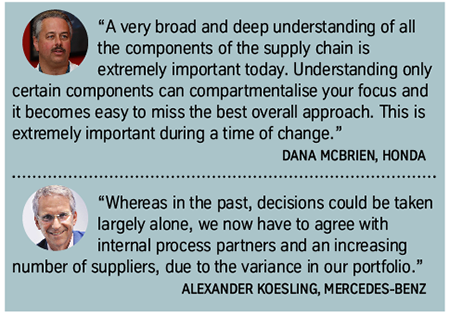 Similar to the skills of their own employees, executives want logistics providers who are already more adept at IT and technical skills, and can continue to exploit new technology and digitalisation. They praise companies that are today far more transparent in their business and service than in the past, but which will need to be even more open and connected to survive.
Similar to the skills of their own employees, executives want logistics providers who are already more adept at IT and technical skills, and can continue to exploit new technology and digitalisation. They praise companies that are today far more transparent in their business and service than in the past, but which will need to be even more open and connected to survive.
Almost all executives emphasise that logistics providers need to be reliable, flexible, efficient, deliver with high quality, continuously improve and offer the best cost. These expectations are unlikely to change, but the processes, equipment and knowledge needed to achieve them will.
IT systems and connectivity are among the most important qualities. 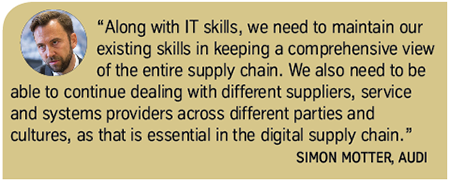 Thomas Zernechel says providers need to guarantee full electronic connectivity and offer more automated services, such as warehouse management. Dana McBrien also stresses the need to keep IT systems and software in line with customer needs. At Kia, Kevin Kinsey wants to see more integrated systems across providers to help streamline logistics processesand visibility, including using GPS and other tracking technology to replace phone calls and emails.Logistics providers also need to be able to provide such visibility
Thomas Zernechel says providers need to guarantee full electronic connectivity and offer more automated services, such as warehouse management. Dana McBrien also stresses the need to keep IT systems and software in line with customer needs. At Kia, Kevin Kinsey wants to see more integrated systems across providers to help streamline logistics processesand visibility, including using GPS and other tracking technology to replace phone calls and emails.Logistics providers also need to be able to provide such visibility  across countries and regions, and help carmakers anticipate issues and respond faster.
across countries and regions, and help carmakers anticipate issues and respond faster.
An executive at one major carmaker notes that logistics providers must also ensure their equipment is up to date. That includes not only IT, but also the size of their transport assets. With the rise in SUVs, as well as vehicles generally growing in length, width and height in most major markets, some legacy equipment for outbound logistics – including vehicle hauliers, rail wagons and storage garages – increasingly struggle to handle new vehicles without higher damage risk.
Dana McBrien also stresses the need to train and retain employees, especially drivers.
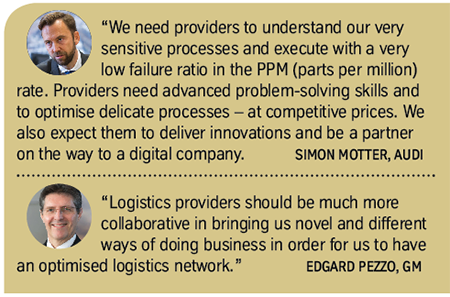 At Ford, Dirk Willmann says he expects innovation, and wants to hear their ideas on new technology. Above all, executives want providers to be more proactive, whether in adapting new systems or changing to new fuels and sustainable transport ahead of regulations. Thomas Zernechel and Alexander Koesling encourage companies to look to digital start-ups bringing new ideas and applications to logistics. In China, CFLP’s Ma Zengrong says that providers and manufacturers need to be ready to collaborate more closely in the face of continuing change.
At Ford, Dirk Willmann says he expects innovation, and wants to hear their ideas on new technology. Above all, executives want providers to be more proactive, whether in adapting new systems or changing to new fuels and sustainable transport ahead of regulations. Thomas Zernechel and Alexander Koesling encourage companies to look to digital start-ups bringing new ideas and applications to logistics. In China, CFLP’s Ma Zengrong says that providers and manufacturers need to be ready to collaborate more closely in the face of continuing change.
McBrien also thinks providers shouldn’t limit their view of what they might be able to do for their customers. He points to tightening resources across multiple OEMs, which could open the door to new service areas and relationships across the supply chain.
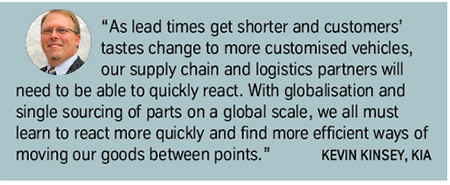

This article is one of a series of pieces celebrating Automotive Logistics’ 20th anniversary issue that together take an extended look at the way top executives feel automotive production and logistics have changed in the last two decades – and where they see them heading in the future.
The full series includes:
Production & logistics part 1: Where are we now?
Production & logistics part 2: Questioning the future
Production & logistics part 3: Operations, packaging and IT
Production & logistics part 4: Logistics organisations and skills
Production & logistics part 1: Where are we now?
- 1
- 2
- 3
- 4
 Currently reading
Currently readingProduction & logistics part 4: Logistics organisations and skills






























